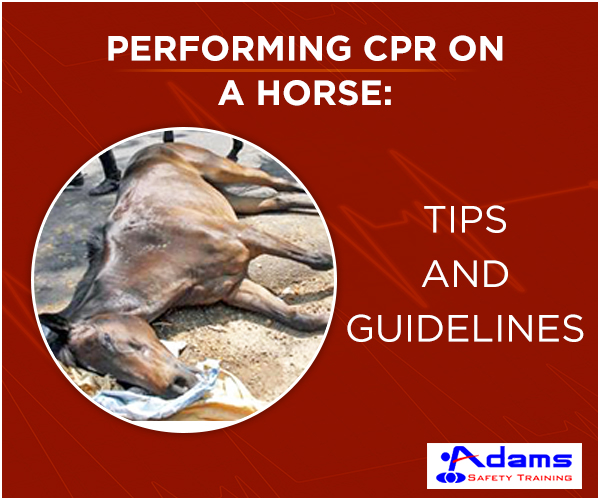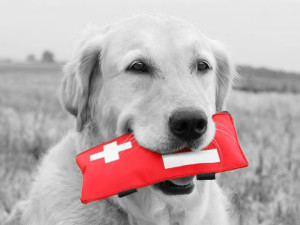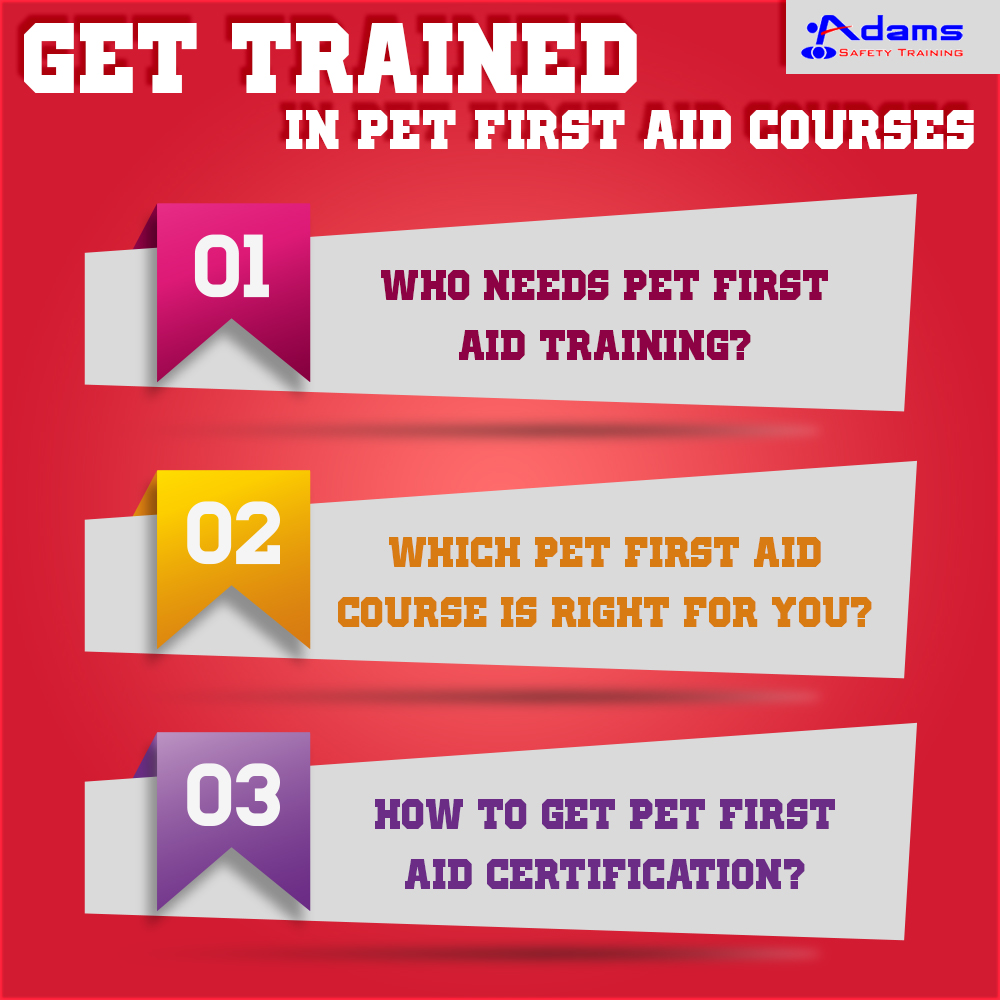
Category Archives: Pet CPR
Pet CPR & First Aid [Infographic]

Performing CPR on A Horse: Tips and Guidelines
Farms animals have different airways from us. If you are using farm animals or petting it then you must get pet CPR training from a certified training institute.
Here are the common guidelines for performing CPR on a horse.
• You should always keep a foaling kit and a resuscitation bag with yourself, if you own a horse or you have foaling training
• Just like the usual CPR, check the obstruction in the airways if there is any. Remove all the birth debris mucus or amniotic fluid, in the foals, if it is present.
• Try stimulating breathing by rubbing the foal with towels for 20 to 30 seconds. You can tickle the nostrils or stick your fingers in its ear if at first attempt it is not revived.
• Next attempt is adapting emergency ventilation support. The Foal should be positioned on its right side and the mask should be placed on its nose. You can also take assistance from someone to extend the neck of the foal and put firm pressure along the left side of the neck. This prevents the air entering the stomach during resuscitation.
• Use both the hands to squeeze the resuscitation bag at a rate of 10 to 20 breaths per minute, for forcing the air into the lungs.
• Check heartbeat. If it is less than 40 beats per minute or it is less than 60 per minute but not increasing; then prepare to give chest compressions.
• Place the Foal on a firm, dry surface. Support it with rolled towels under the thorax. Place the hands at behind the foal’s triceps at the highest point of the thorax.
• Perform the compressions at a rate of 80 to 120 a minute. The resuscitator can be relieved every two minutes

How to Perform CPR on a Dog – [INFOGRAPHIC]
In the past due to the lack of evidence-based CPR guidelines in the veterinary demesne, the animals could not be given proper first-aid and CPR in the case of medical emergencies. This, however, will not be the case now as AHA has provided upgraded guidelines for the proper cardiopulmonary resuscitation for animals.
The given Infographic delineates these upgraded guidelines.
• The sequence should be remembered as ABC, Airway, Breathing and Cardiac Compressions
• The dog should be laid on the flat surface with its head extended to clear airway
• Check and remove any obstructions in the jaw and cup your hands around the mouth in a way that nostrils are remained open and blow the air into the nostrils at the rate of 20 breaths per minute
• Perform 100-120 chest compressions per minute. Both the palms should be placed down in the chest cavity of the bones. Dogs such as bulldogs have barrel chest therefore, the compression should be directly aimed at the heart while the dog lay on its back. For dogs with narrow chest cavity, push down near to its armpits directly over the heart
• Perform CPR in two minutes cycles and check for breathing and keep administering the vasopressors every 3-5 minutes during the CPR.
For more information and guidelines go through the Infographic given below;

Get CPR Trained for a Pet Emergency
Do you find yourself unequipped at the time of pet emergencies? As a pet sitter, are you looking for proper training that can add value to your resume and help you get new clients?
What do Pet Training Classes offer?
• Helps you understand basic pet owner responsibilities
• You can administer medicine
• Managing breathing and cardiac emergencies
• Assessing vitals in case of pet emergencies
• Managing urgent care situation
• Treating wounds
• Treating electrical shock
• Preparing for disasters
Choose the Right Training
It will be wise to choose a training that adds value to your resume. Choose a training that equips you to tackle unexpected issues and accidents. Also trainings should prepare you avoid accidents from taking place. As a pet sitter or owner you need to understand the pet’s personality. Take the course that will help you address their safety concerns.
Where from should you do Pet CPR and First Aid Course?
Pet CPR and First Aid Course can be done online or in a one-on-one personal training session or group class. Many organizations like the American Red Cross offer these courses globally. Learn CPR or First aid for all exotic animals and not just cats and dogs.
Keep a Pet Emergency Preparedness Kit ready always
• Keep medications and medical records in a waterproof container and a First Aid kit ready.
• Keep strong leashes, harnesses, and/or carriers to transport pets safely ensuring that your animals can’t escape.
• Keep current photos of your pets in case they get lost.
• Food, drinkable water, bowls, cat litter/pan, and manual can opener need to be placed in the kit
• Information on feeding schedules, medical conditions, behavior problems, and the name and number of your veterinarian in case you have to foster or board your pets.
• Pet bed or toys if easily transportable.
Get trained in Pet First Aid Courses
What would you do if your dog experiences sudden cardiac arrest? What would you do if your cat has ingested something poisonous? Unfortunately, people, who are not trained in pet first aid courses, don’t have answers to these questions, but accidents can happen at any time. Having knowledge of how to provide first aid to pet animals when emergency arises can help you save a life.
Who needs pet first aid training?
Pet first aid courses provide the knowledge and skills required to respond efficiently and quickly in case of emergency. Pet owners, pet caretakers, and pet professionals such as dog walker, pet sitter, and pet groomer should attend pet first aid training classes.
Which pet first aid course is right for you?
A basic first aid/CPR class is good for pet owners, but professionals need to take up more advanced courses. There are specific first aid classes for pets such as dogs and cats & for specific conditions such as choking, trauma, poisoning, heart stroke, etc. Pet first aid course length varies from 2-4 hours and certifications are valid for 2 years.
How to get pet first aid certification?
Animal veterinary hospitals and animal safety organizations provide first aid training to professionals. You can find a local pet first aid training provider to get certified in Pet first aid/CPR.
Confidence and skills come only with training. Being prepared can help you increase a pet’s survival chance and buy some time until emergency veterinary care professionals arrive at the site.
Saving a Pet’s life with CPR
What would you do if your pet collapsed? A pet could collapse due to choking, trauma or electrocution. Cardiopulmonary resuscitation (CPR) is a life-saving procedure which is performed when the victim’s heart beat and breathing have stopped. CPR can be performed on pets as well—as long as you know a few basic rules.

How to do CPR on pets?
Step 1: Call a veterinarian immediately or get someone drive you to a veterinary clinic. By the time, you can check for breathing and pulses and start the CPR process either at your home or at the backseat of your car. Place the pet on a flat surface, with the left side up and the right side down.
Step 2: Cup your hands and place one palm on either side of the pet’s heart. Compress the chest for one-quarter to one-third of the chest width at a rate of 80 compressions per minute for dogs more than 30 pounds. For dogs that weigh less than 30 pound, do it for 100 times a minute while for cats, compression rate should be 120 beats per minute.
Step 3: Before you give artificial respiration, close the pet’s mouth and breathe into the pet’s nose one time for every five compressions. If two persons are available at the time, give artificial respiration once for every two compressions are done.
Step 4: Continue performing CPR on Pet until the pet begins to breathe and has a steady pulse or a veterinarian attends to your pet.
Pet owners who attend CPR classes can prepare themselves to react quickly in emergency situations. Remember, you can buy time by performing CPR till you get to a vet.



